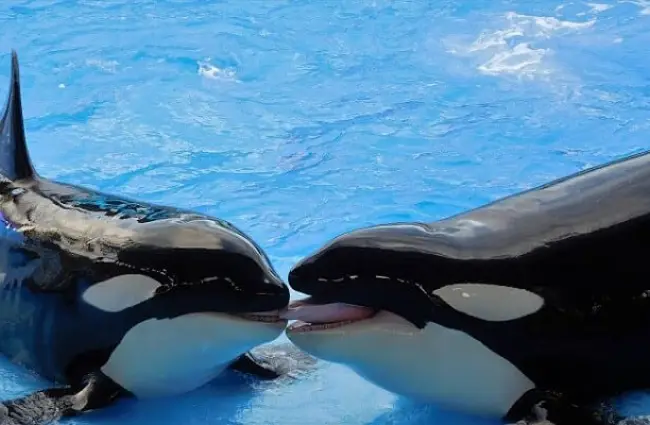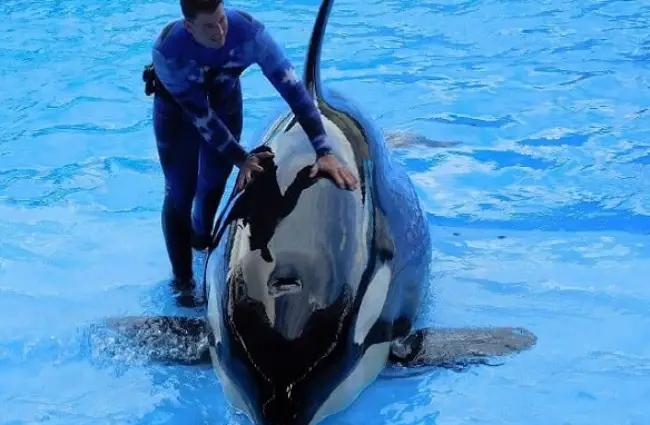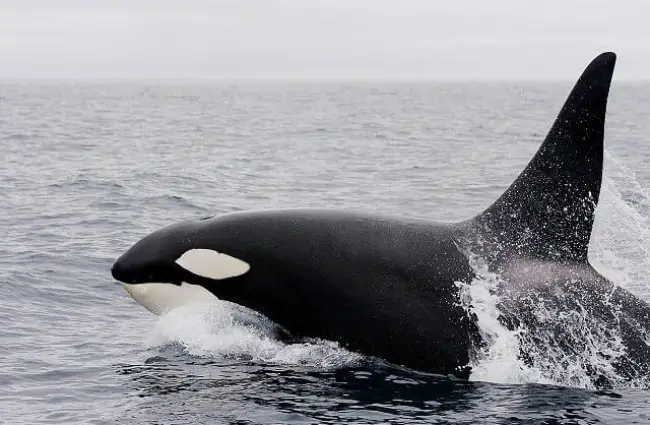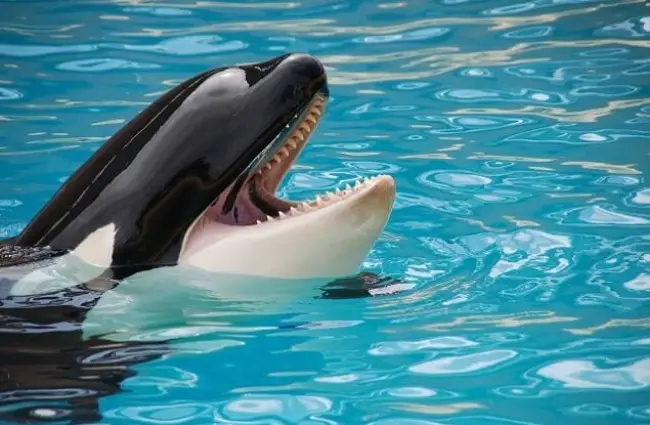The killer whale is one of the largest of the toothed whales, and possibly the most famous. Also called “orcas,” killer whales are incredibly intelligent predators, which hunt a variety of prey species. Because killer whales can be kept in human care, we conduct more thorough scientific research about them than some of the other whale species. Read on to learn about the killer whale.
Description of the Killer Whale
The killer whale is one of the most recognizable marine mammals, namely due to their black and white pattern, and large size. The killer whale has round pectoral fins on either side of its body, a large dorsal fin on its back, and a tail fin – called a “fluke.” The entire body size, as well as the pectoral and dorsal fins, increases proportionally in male killer whales.
Interesting Facts About the Killer Whale
Because orcas are so intelligent, they have the wonderful ability to spark human interest. Both in human care and in the wild, people flock to catch a glimpse of the amazing killer whale. Learn more about these fascinating marine mammals below:
- Killer Whales are Actually Giant Dolphins – Just like the sperm whale, killer whales are not “true” whales at all – they are toothed whales. The typical “true” whale, such as blue and humpback whales, are baleen whales. Baleen whales feed by filtering fish out of mouthfuls of water through modified plates of baleen “teeth.” Toothed whales have conical shaped teeth used to grab fish, and are commonly referred to as “dolphins.” Killer whales are more closely related to bottlenose dolphins than humpback whales, because they share the family Delphinidae. Many, but not all, toothed whales share the family Delphinidae. Killer whales are actually the largest members of the dolphin family.
- Whale Watching, the “Harmless” Pastime – Over the past decade or so, whale watching has become increasingly popular. Boats packed to the rails with tourists cruise into the open ocean, hoping for a glimpse of wild whales. This attraction is not a harmless tourist activity. In fact, research shows that killer whales are spending less time feeding due to whale watching ships. Less time eating equals less energy, less energy equals lower reproduction and survival rates overall.
- Husbandry Behaviors – Whales, dolphins, and many other species in zoos and aquariums, are taught to voluntarily participate in their own care – also known as husbandry behaviors. Some medical procedures the animals are taught to voluntarily participate in include blood draws, breath samples, urine samples, fecal samples, weighing, stomach tube insertion, transport/crate/stretcher, and physical examinations. They can be trained to do virtually anything! Regular medical samples help keep the killer whales happy and healthy.
- Built-In Camouflage – Though they may not look it, killer whales are actually very well camouflaged in the water! Because they are dark on top, and light on their stomach, they have a type of camouflage called countershading. When viewing the whale from below, the light coloration of its stomach helps it blend in with the sunlight above them. When viewing the whale from above, the dark coloration of its back helps it blend in with the dark depths below.
Habitat of the Killer Whale
Killer whales frequently inhabit coastal and offshore seas, particularly areas of cold-water upwelling. Cold-water upwelling occurs in areas where deep-sea currents push cold, nutrient-rich waters to the surface. The entire ecosystem thrives in areas of upwelling because of these nutrients.
Distribution of the Killer Whale
Killer whales can be found in oceans worldwide, though they are found in greater numbers in the Arctic and Antarctic. They will also congregate in areas of upwelling, but these areas can change seasonally.
Diet of the Killer Whale
Killer whales feed on a variety of fish, including salmon, herring, sharks, and stingrays. Some whales will follow the migration of salmon, which can account for up to 96% of their diet. Killer whales will also prey on herring, using “carousel feeding.” The whales herd the fish into a small group, and attack them using their tail fins. When hunting sharks, killer whales appear to target the animal’s oil-rich liver.
Some killer whales also prey on marine mammals, from seals, to whales, to smaller dolphins. When hunting large whale species, killer whales target young or sick individuals. They will isolate and drown their prey before feeding. When killer whales hunt smaller marine mammals they will toss, ram, or otherwise disable them.
The Two Main “Types” of Killer Whales
- Resident – Populations of “resident” killer whales feed on a local prey source, and remain in one location. They will follow a preferred food source, such as salmon, and feed on that prey in a regional location. Resident killer whale pods feed almost exclusively on fish.
- Transient – Populations of “transient” killer whales roam longer distances, feeding on marine mammals. They tend to travel in smaller pods than residents, with pod sizes ranging from pairs to six animals.
Killer Whale and Human Interaction
In the beginning of the commercial whaling era, killer whales were seldom targeted. Compared to the larger whale species, the killer whale contains less useable oil, making it a less profitable option when whaling. Unfortunately, when the larger whale species were depleted, whalers began to hunt killer whale populations, despite the reduced profit margin.
Small populations of killer whales are also kept in aquariums across the world. They are renowned for their intelligence, and are capable of learning many different behaviors. Killer whales are trained using positive reinforcement, and are even capable of assisting in their own preventative healthcare – known as husbandry training.
These whales can also be trained to react to different types of stimuli, which is useful in scientific research. Some of the research that has been conducted using voluntary training methods, where animals are trained to perform the behaviors to conduct research or provide samples without anesthetization, includes: hearing/auditory thresholds, eyesight, learning and memory capabilities, hormone concentrations at different life stages, and vocalization types.
Domestication
Killer whales may be kept in human care, but they are not domesticated in any way.
Does the Killer Whale Make a Good Pet
Killer whales do not make good pets! They are protected under the Marine Mammal Protection Act, and require extensive permits and inspections to house in an education or research facility. They also require copious amounts of fish for their daily care, and advanced veterinary care to maintain their health.
Killer Whale Care
In aquariums, adult killer whales are fed between 1% and 3.5% of their body weight. This equates to a minimum of 50 lbs. of fish every day, for an average sized (5,000 lb.) female killer whale. They are also provided with a variety of toys to play with every day – this is called “enrichment.” Some enrichment that is provided to killer whales include:
- Heavy-duty plastic floats
- Boomer balls (another heavy-duty toy)
- Car wash flaps
- Unflavored gelatin
- Ice pieces, or large ice blocks with fish inside
- Toys “glued” together with gelatin
- Water hose play
- Massages/tactile interaction
- Training sessions/games
Behavior of the Killer Whale
Resident killer whales are typically found in pods composed of females and their offspring – this is called a “matriline pod.” In matriline pods, individuals are extremely bonded, and remain in long-term cohesive groups. These pods can consist of a single generation of animals (a mother and her offspring), or up to four generations of animals (great grandmother, grandmother, mother, offspring).
Reproduction of the Killer Whale
In female killer whales, sexual maturity typically occurs when an individual reaches 15-18 ft. in length. This means the average age of sexual maturity can be anywhere from 7-16 years of age. Male killer whales reach sexual maturity at around 15 years of age.
A female will come into heat multiple times per year, in a process called “polyestrous.” They are polygamous, meaning they will mate with multiple partners, typically the largest and strongest males. Approximately half of female killer whales reach menopause by 38 years of age, which means they can no longer reproduce.













![Red Angus Closeup of a beautiful Red Angus cowPhoto by: U.S. Department of Agriculture [pubic domain]https://creativecommons.org/licenses/by/2.0/](https://animals.net/wp-content/uploads/2020/03/Red-Angus-4-238x178.jpg)












![Red Angus Closeup of a beautiful Red Angus cowPhoto by: U.S. Department of Agriculture [pubic domain]https://creativecommons.org/licenses/by/2.0/](https://animals.net/wp-content/uploads/2020/03/Red-Angus-4-100x75.jpg)

